

Attention Deficit Hyperactivity Disorder (ADHD) Diagnosis.
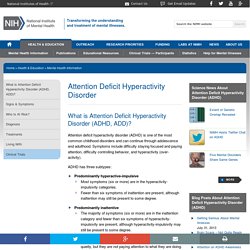
About ADHD: Hyperfocus. It's no secret that children and adults with attention deficit disorder (ADD ADHD) often struggle to focus on tasks they find uninteresting.
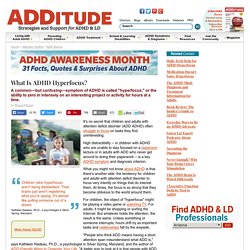
High distractibility -- in children with ADHD who are unable to stay focused on a classroom lecture or in adults with ADD who never get around to doing their paperwork -- is a key ADHD symptom and diagnosis criterion. What you might not know about ADHD is that there's another side: the tendency for children and adults with attention deficit disorder to focus very intently on things that do interest them. At times, the focus is so strong that they become oblivious to the world around them. For children, the object of "hyperfocus" might be playing a video game or watching TV. For adults, it might be shopping or surfing the Internet. Adderall. While concerns have been raised over side effects and rare, serious complications, Adderall is generally well-tolerated and effective.[3] The most common side effects are cardiovascular, such as fast or irregular heartbeat, and psychological, such as anxiety.

Adderall is a common drug of abuse. [citation needed] However, abuse or dependence is very unlikely to develop in those who use it as prescribed. [citation needed] Uses[edit] Medical[edit] Adderall is generally used for the treatment of ADHD and narcolepsy, the two conditions for which the United States Food and Drug Administration has approved its use.[4] However, it is sometimes prescribed off-label for other conditions such as depression.
Adderall oral : Uses, Side Effects, Interactions, Pictures, Warnings & Dosing. Loss of appetite, weight loss, dry mouth, stomach upset/pain, nausea/vomiting, dizziness, headache, diarrhea, fever, nervousness, and trouble sleeping may occur.
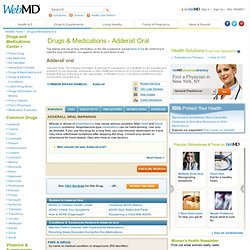
If any of these effects persist or worsen, tell your doctor promptly. Remember that your doctor has prescribed this medication because he or she has judged that the benefit to you is greater than the risk of side effects. Many people using this medication do not have serious side effects. This medication may raise your blood pressure. Check your blood pressure regularly and tell your doctor of any high results. The underground world of neuroenhancing drugs. A young man I’ll call Alex recently graduated from Harvard.

As a history major, Alex wrote about a dozen papers a semester. He also ran a student organization, for which he often worked more than forty hours a week; when he wasn’t on the job, he had classes. Weeknights were devoted to all the schoolwork that he couldn’t finish during the day, and weekend nights were spent drinking with friends and going to dance parties. “Trite as it sounds,” he told me, it seemed important to “maybe appreciate my own youth.” The Mysteries of ADD and High IQ. We recently published a study of 117 high IQ children and adolescents with ADD. (Note: In this article, the term ADD is used to refer to both ADD and ADHD ). All of these very bright students were struggling in school and often also in social relationships because of their ADD-related problems.
Results from that study uncovered a pattern of vulnerabilities in executive functions, the management system of the brain , that caused these bright students to have chronic difficulty in focusing on their work, in getting their work done adequately, in keeping in mind what they had just heard or read, and in organizing and completing assignments. Some have been mystified as to how very bright students could suffer from ADD. They assume that being smart protects a person from the difficulties associated with ADD. Here are 5 questions that our research team repeatedly encountered from high IQ kids and their parents and teachers: 1.
No! 2. ADD has nothing to do with how smart a person is. 3. 4. 5. Attention Deficit Hyperactivity Disorders (ADHD) Homepage - NCBDDD. ADHD Diagnosis and TreatmentNew data on trends and age of diagnosis.Learn More » Children's Mental DisordersA Journey for Parents and Children Learn More » Medscape VideoADHD: Do parents know If Their Child Has Been Diagnosed?
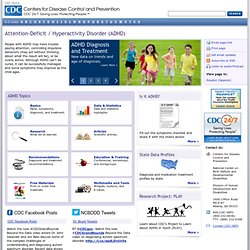
Learn More » Updated GuidelinesChildren can now be diagnosed and treated for ADHD from ages 4 to 18.Learn More » People with ADHD may have trouble paying attention, controlling impulsive behaviors (may act without thinking about what the result will be), or be overly active. Although ADHD can't be cured, it can be successfully managed and some symptoms may improve as the child ages. What Is ADHD? Lisa's son Jack had always been a handful.
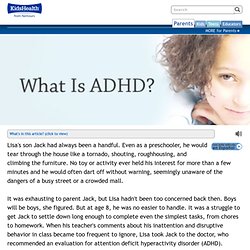
Even as a preschooler, he would tear through the house like a tornado, shouting, roughhousing, and climbing the furniture. No toy or activity ever held his interest for more than a few minutes and he would often dart off without warning, seemingly unaware of the dangers of a busy street or a crowded mall. It was exhausting to parent Jack, but Lisa hadn't been too concerned back then. Boys will be boys, she figured. But at age 8, he was no easier to handle. ADHD is a common behavioral disorder that affects an estimated 8% to 10% of school-age children. Attention deficit hyperactivity disorder. Attention deficit hyperactivity disorder (ADHD, similar to hyperkinetic disorder in the ICD-10) is a psychiatric disorder[1][2] of the neurodevelopmental type[3][4] in which there are significant problems of attention, hyperactivity, or acting impulsively that are not appropriate for a person's age.[5] These symptoms must begin by age six to twelve and be present for more than six months for a diagnosis to be made.[6][7] In school-aged individuals the lack of focus may result in poor school performance.
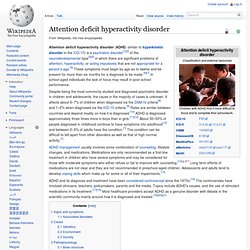
Despite being the most commonly studied and diagnosed psychiatric disorder in children and adolescents, the cause in the majority of cases is unknown.